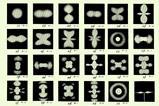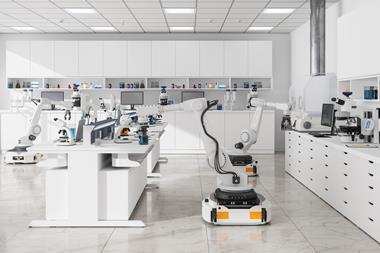Ubiquitous images of nanobots are 20,000 leagues from reality, warns Phil Ball
With the steely purpose of a translucent mite, the microsyringe machine holds a red blood cell in its tweezer-like grasp as it injects a drug. The image (below) is such a seamless blend of photographic reality and graphic invention that many who see it have doubtless been persuaded that such things exist.
This award-winning picture has accompanied countless articles on nanotechnology, where it trades on the discipline’s most enduring creation in the public imagination: the nano-robot or nanobot. These devices, it is said, will patrol our bloodstream, patching up damage and repelling invaders. They could clean up the environment or explore remote realms. The imagery of nanobots in the Science Photo Library collection has been studied in a recent paper by social scientist Brigitte Nerlich of the University of Nottingham.1
Nerlich points out that, while nanotech has some iconic images based on actual experiments, popular accounts are more often accompanied by stock images like the microsyringe, showing ‘a world that might be there in the future but probably never will’. They come from the tradition of utopian science fiction, harking back to the illustrations in the novels of Jules Verne. What they depict are not things that exist or are in development, but metaphors - although this may not be obvious to the viewer.
Nerlich wonders whether nanobots were ‘a kind of rope-ladder thrown out to the public by scientists and science popularisers to acquaint it with nanoscience and nanotechnology’. But most scientists in this field would have preferred to offer quite different means of access. ‘Among the more sober nanobusiness and nanoscience types, the word nanobot is shorthand for everything they despise about the science fiction visions that nanotechnology has attracted’, says Richard Jones, one of the most respected commentators on nano-affairs.
The nanobot stemmed from K Eric Drexler’s vision of nanotechnology outlined in his 1986 book Engines of Creation, where he depicted nanoscale robotic ‘assemblers’ that built structures atom by atom like an automated assembly line. Drexler speculated that such devices might be able to construct copies of themselves, leading to the infamous ‘grey goo’ of nanobot replicators run amok.
![]()
Drexler was never part of the nanotechnological mainstream, but it captured the limelight. Scientists lamented this traducing of their research, but perhaps the key question is why such things happen at all, and what effect they have.
It isn’t clear that anyone - not even Prince Charles - ever really believed in grey goo. As with the apocalyptic fears about the Large Hadron Collider, this just traded on the frisson in the time-honoured Faustian image of mad scientists destroying the world. The striking thing about stock images of nanobots, however, is that they aren’t shown as marauding grey goo, but rather, as our little friends, zapping viruses and cleaning arteries.
Yet nanobots are not an absurd idea. It is just that they won’t look anything like the library pictures. In 2002, for example, systems biologist Jeff Hasty and his colleagues described what may become possible from reprogramming living cells: ‘Ultimately, synthetic gene circuits encoded into DNA might be ‘downloaded’ into cells creating, in effect, a "wet" nano-robot.’2
Very recently this idea has been blended with nanotechnology by Nadrian Seeman of New York University and Hao Yan at Arizona State University. They and their colleagues have figured out how to replicate DNA nanostructures using living cells, by splicing the DNA sequences into strands that look like bacterial virus (phage) genomes, which can infect E. coli cells and be replicated as the colony grows.3
This is not something that can be easily shown in a colourful picture. Perhaps more to the point, it is not an easy concept to grasp, not least because it mixes the living and the synthetic worlds that most people prefer to regard as strictly distinct realms. The persistence of shiny mechanical nanobots shows us how the microscopic sciences have failed to get across a crucial message. Ever since the work of Jean-Marie Lehn and others on supramolecular chemistry, it has made sense to see chemistry as an information science - as Lehn put it, a science of ‘informed matter’. This is what microbial nanotechnology (and its natural counterpart, life) is all about: transmitting chemical information encoded in molecular structure. Compared with robots, that’s a rather abstract notion - but not impossibly so. As Hasty’s team indicate, the appropriate metaphors are instead to be found in computer technology.
All this is a far cry from the crude literalism with which nanobots seem to manipulate matter in the SPL pictures. Nerlich suggests that we can take some comfort from the benign image they project, and perhaps she is right. Their biggest flaw is that they (like Drexler) impose a falsely mechanical view of the atomic rearrangements that are chemistry’s fundamental task, threatening to obscure chemistry’s centrality to the nanotech agenda.
References
1 B Nerlich, Sci. Cult., 2008, 17, 269
2 J Hasty, D McMillen and J J Collins, Nature, 2002, 420, 224
3 C Lin et al, Proc. Natl Acad. Sci. USA, 2008, DOI: 10.1073/pnas.0805416105

















No comments yet